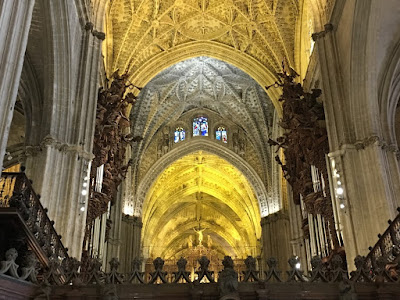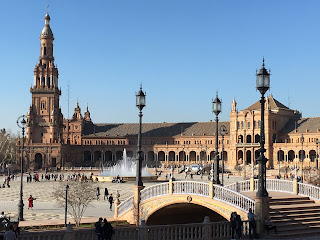We hoped for warmer weather, and we came prepared for rain. But this last month, we've seen no rain at all, and the temperatures have hovered around 70F, a sharp contrast to those snowy days back home.
Once we adjusted to that 9 hour time change that flipped morning to night, we discovered so many small differences in everyday life.
Our apartment is situated just two blocks away from the monumental Plaza of Seville, so well decorated with traditional tiles (
azuelos), though we haven't found a factory to visit -- yet.
Anytime we like, we stroll over to the Plaza through an expansive park. True, this particular park is one where many were put to death during the Spanish Inquisition, but today, fountains and greenery mask the past.
Just across the street from our apartment, we drop by
Mas y Go, a convenience store with its own bakery (
pastelria). Think fresh bread, crusted rolls, croissants, and bite-sized flaky pasteries for breakfast -- along with other convenience foods.
People eat at different hours here -- breakfast somewhere around 10 am, lunch at between 3-4 pm, and then dinner at 9-ish. But, the streets are lined with sidewalk cafes for those who wish for a coffee or snack in the meantime. We stroll along leisurely. No one is in a hurry. In the afternoon, we stop for
cafe con leche in small espresso cups with enough coffee to fuel us to another museum.
A word about
tapas, those 'little plates' with a variety of 'little bites.' We've already tried four meatballs in a tasty sauce and fried squid, crisp and delicately flavored. Two such
tapas make a meal for us, along with a nice glass of
sangria.

Everywhere we've had our supper, the sangria has tasted different. I think I know why. At a late dinner stop at a nearby tapa bar, we watched in amazement as the bartender filled this massive glass jar with sangria.
First, he took a small glass, sniffed the sangria, and then tasted it. He must have been cleaning out the bar as he poured from every known bottle of alcohol and several large fruit juice bottles -- right into the sangria!
Just a final word about drivers here in the city. They go at speed, motorbikes zipping along. Very, very few pedestrians cross against the light, but drivers politely wait, even as the crossing light chirps to let us know when only 3 seconds remain. No one turns right against the light. And the cars, some of them, actually turn off when they stop -- No nasty exhaust! But . . . everyone smokes. Young, old, and in between.
Yesterday, we sat on a bench, watching the passersby while eating fresh gelato. Earlier, somewhere near, teams had played rugby. So we listened and wondered where this shouting of team songs came from. Turned out there was a bar on the corner we passed on the way home. The team members enthusiastically celebrated their win!
I hope this gives you a little flavor of life here in Seville. Most days are calm, filled with excursions and amazingly delicious food. I hold my glass of sangria up to you, in celebration of another beautiful day!

























